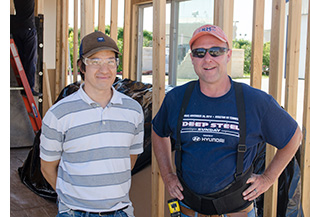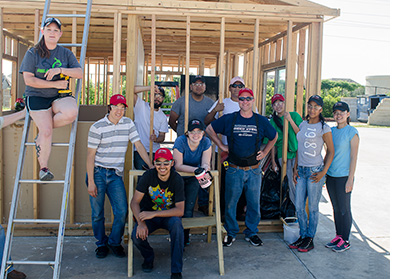This spring, Lone Star College-CyFair’s Architectural and Fire Science programs teamed up to provide real world, hands-on career training opportunities for students.
Professor Bill Arnold’s construction class designed and built a 15' x 32' “Arson Investigation” house so various emergency services program students could practice and hone investigation and life-saving skills.
 The student team of Mark Hempton and Sean Lester won Arnold’s “Construction Design Competition" with their one-story wooden house that includes a living room, kitchen, dining, pantry, master bedroom and bath. Hempton, who already has an English literature degree, but decided to earn an AutoCad Certificate toward a computer-aided design career, did the elevation drawings. Lester, who has been in construction all his life, but decided to return to school to earn a degree to help him move up the ladder, did the floor plans
The student team of Mark Hempton and Sean Lester won Arnold’s “Construction Design Competition" with their one-story wooden house that includes a living room, kitchen, dining, pantry, master bedroom and bath. Hempton, who already has an English literature degree, but decided to earn an AutoCad Certificate toward a computer-aided design career, did the elevation drawings. Lester, who has been in construction all his life, but decided to return to school to earn a degree to help him move up the ladder, did the floor plans
In this very close competition, EMS Program Coordinator Alan Blankenship said judges narrowed eight designs to two and had to have adjunct professor Rodney Janczak break the tie.
“The winning design had to be the most feasible to use for multiple purposes - to do search and rescue calls, to respond to mock EMS calls staged with mannequins and to find the origin of small fires from shorted out toasters, coffee pots or small appliances,” said Blankenship.
The design duo said it was great to win and get bonus points in class, but were also glad to be able to design a structure that would help train the fire cadets. Arnold said that his students benefit from this semester-long project, too.
“My students learn teamwork, construction methods and analytical thinking to snap out quick design decisions,” he said. “And like any as-built project, the students learn that things happen differently in the field than what they put on paper.”
 In addition to the house, Arnold’s students built three training props for the fire academy cadets: an entanglement simulator for training if one is caught in an attic space or crawl space with hanging wires; a diminished clearance prop in which cadets have to squeeze through between an 18 inch square space between studs; and a window bail out simulator in which cadets overcome by fire bail out of a window and hang out an elevated residential size window.
In addition to the house, Arnold’s students built three training props for the fire academy cadets: an entanglement simulator for training if one is caught in an attic space or crawl space with hanging wires; a diminished clearance prop in which cadets have to squeeze through between an 18 inch square space between studs; and a window bail out simulator in which cadets overcome by fire bail out of a window and hang out an elevated residential size window.
“It’s great to have resources available from the architectural department to assist us in building these simulators to help better our fire cadets with skills to go out into the world and find jobs,” said Blankenship. “For a one-semester program, their construction quality is very good.”
Blankenship said there is already discussion of roof simulation props to practice ventilation techniques – a structure to introduce cadets nervous about heights to using power tools while elevated, but low to the ground before moving to a full-size elevated roof.
Having built two training props in Fall 2013, this is the second partnership between LSC-CyFair’s Architectural and Fire Science programs, and not the last. Arnold said will repeat the design competition and construction of a new house each fall and spring.
For information on the Architectural program, contact Arnold at William.J.Arnold@lonestar.edu. For information on Fire Science programs, contact Blankenship at Alan.Blankenship@LoneStar.edu.
